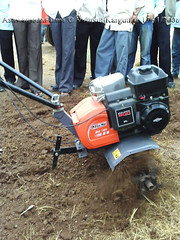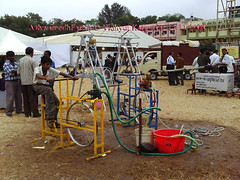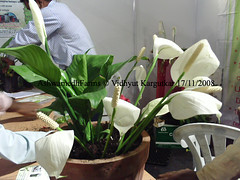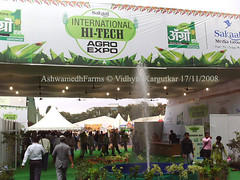I also saw this coconut twin plant on sale!
And if you believe this is weired see the link below!!! :o
http://coconutfreaks.blogspot.com/2006/01/multi-headed-coconut-palms.html
Tuesday, December 9, 2008
Ashwagandha
Withania somnifera, also known as Ashwagandha, Indian ginseng, Winter cherry, Ajagandha, Kanaje Hindi and Samm Al Ferakh, is a plant in Solanaceae or nightshade family.
The roots and berries of the plant are used in herbal medicine. It grows as a stout shrub that reaches a height of 170cm. It is commercially cultivated in Madhya Pradesh.
The main constituents of ashwagandha are alkaloids and steroidal lactones.
Ashwagandha in Sanskrit means "horse's smell", probably originating from the odor of its root which resembles that of sweaty horse.
The Ashwagandha plant has also become a target of patent seeking overseas firms as can be seen in this TOI report, please click on link:
http://www.hvk.org/articles/0501/69.html
The roots and berries of the plant are used in herbal medicine. It grows as a stout shrub that reaches a height of 170cm. It is commercially cultivated in Madhya Pradesh.
The main constituents of ashwagandha are alkaloids and steroidal lactones.
Ashwagandha in Sanskrit means "horse's smell", probably originating from the odor of its root which resembles that of sweaty horse.
The Ashwagandha plant has also become a target of patent seeking overseas firms as can be seen in this TOI report, please click on link:
http://www.hvk.org/articles/0501/69.html
Rudraksha plant
A rare sight to see nowadays was this "rudraksh" plant for sale (both round and elongated).
Each plant was for Rs. 500 only but i had spent my money on buying books hence i couldnt buy even a single one. :(
It so happens that people will spend money like crazy for buying beads but there arent many takers for conservation and propagation of the plant itself!
Unfortunately even i didnt take the name of the exhibitor who had on sale rare plants as well as our regular garden varieties.
Some Information on rudraksh plant:
Rudraksha is the name of the dark berries of Elaeocarpus ganitrus, used to make prayer beads. The word is a Sanskrit compound consisting of the name Rudra and ākṣa meaning eye. Latin name 'ganitrus' possibly taken from ganitri, the name for this species in Sundanese and Malay.
The Rudraksha is a large evergreen broad-leaved tree that grows in the area from the Gangetic plain to the foothills of the Himalayas. Rudraksha trees are also found in middle areas of Nepal. Rudraksha seeds are covered by an outer shell of blue color when fully ripe, and for this reason are also known as blueberry beads. The blue colour is derived not from pigment but is structural.
A report by I.I.S.C. on the dwindling numbers of rudraksha tress and rampant felling and collection of seeds leading to loss of rudraksha trees across India. File is in *pdf format, you will need acrobat for viewing.
http://www.iisc.ernet.in/currsci/mar102004/646.pdf
Pictures of Rudraksha:
http://toptropicals.com/pics/garden/07/479/P5124750.jpg
http://toptropicals.com/pics/garden/07/479/P5124752.jpg
http://toptropicals.com/pics/garden/07/479/P5124753.jpg
On Flickr
http://www.flickr.com/photos/laughingbuddhaz/2988944154/
Each plant was for Rs. 500 only but i had spent my money on buying books hence i couldnt buy even a single one. :(
It so happens that people will spend money like crazy for buying beads but there arent many takers for conservation and propagation of the plant itself!
Unfortunately even i didnt take the name of the exhibitor who had on sale rare plants as well as our regular garden varieties.
Some Information on rudraksh plant:
Rudraksha is the name of the dark berries of Elaeocarpus ganitrus, used to make prayer beads. The word is a Sanskrit compound consisting of the name Rudra and ākṣa meaning eye. Latin name 'ganitrus' possibly taken from ganitri, the name for this species in Sundanese and Malay.
The Rudraksha is a large evergreen broad-leaved tree that grows in the area from the Gangetic plain to the foothills of the Himalayas. Rudraksha trees are also found in middle areas of Nepal. Rudraksha seeds are covered by an outer shell of blue color when fully ripe, and for this reason are also known as blueberry beads. The blue colour is derived not from pigment but is structural.
The berries show variation in the number of grooves on their surface, and are classified on the basis of the number of divisions that they have. A common type has five divisions, and these are considered to be symbolic of the five faces of Shiva.
The Rudraksh seeds are brittle in nature and so should be protected from chemicals.
The best way to find the authenticity of a rudraksha is to get it X-rayed and count the number of compartments inside. If they are equal to the number of lines outside the rudraksha is real.
Rudraksh is also used by people as a rosary while chanting mantras.A report by I.I.S.C. on the dwindling numbers of rudraksha tress and rampant felling and collection of seeds leading to loss of rudraksha trees across India. File is in *pdf format, you will need acrobat for viewing.
http://www.iisc.ernet.in/currsci/mar102004/646.pdf
Pictures of Rudraksha:
http://toptropicals.com/pics/garden/07/479/P5124750.jpg
http://toptropicals.com/pics/garden/07/479/P5124752.jpg
http://toptropicals.com/pics/garden/07/479/P5124753.jpg
On Flickr
http://www.flickr.com/photos/laughingbuddhaz/2988944154/
Rotary Tiller
Rotary tiller is also known as rototiller & rotavator.
Rotating tines or blades turn the soil around.
To keep the machine from moving forward too fast, an adjustable tine is fixed just behind the blades so that through friction with deeper un-tilled soil, it acts as a brake, slowing the machine and allowing it to pulverize the soils. The slower a rototiller moves forward, the more soil tilth can be obtained.
Rototilling is much faster than manual tilling, but notoriously difficult to handle and exhausting work, especially in the heavier and higher horse power models. If the rototiller's blades catch on unseen sub-surface objects, such as tree roots and buried garbage, it can cause the rototiller to abruptly and violently move in any direction.
Rotating tines or blades turn the soil around.
To keep the machine from moving forward too fast, an adjustable tine is fixed just behind the blades so that through friction with deeper un-tilled soil, it acts as a brake, slowing the machine and allowing it to pulverize the soils. The slower a rototiller moves forward, the more soil tilth can be obtained.
Rototilling is much faster than manual tilling, but notoriously difficult to handle and exhausting work, especially in the heavier and higher horse power models. If the rototiller's blades catch on unseen sub-surface objects, such as tree roots and buried garbage, it can cause the rototiller to abruptly and violently move in any direction.
Cycle operated water-lifting pump
Cycle operated water-lifting pump
While i was exploring the grounds, i also saw the greatly innovative "cycle operated water-lifting pump".
A little boy was operating it effortlessly!
The pump has been invented by Vikram Rathore, a small tribal farmer from Narsapur village, Utnoor Mandal, Adilabad in Andhra Pradesh.
For this iinovation he has also won an award from the National Innovation Foundation.
"This is a centrifugal water pump which is run by rotating the pedal of a cycle. The system comprises a bicycle, rim, beltpulley, impeller and inlet and delivery pipes. A bare rim replaces the rear wheel of the bicycle. The rim is connected to another pulley with a smaller diameter. The supporting shaft of the smaller pulley carries another rim for second stage speed increment. The shaft also carries a flywheel to increase momentum of the system. The final supporting shaft is connected with an impeller that rotates at high speed and pumps water. The power (energy) generated through this process of pedaling is used to lift the water and push the water from a pipe into the farm for cultivation. This innovation is useful for pumping water from rivers, ponds, wells and similar water sources thus enabling poor farmers for pumping water for irrigation and cultivation."
As described on N.I.F. site. Kindly visit their website:
http://www.nif.org.in/Cycle_operated_water-lifting_pump
While i was exploring the grounds, i also saw the greatly innovative "cycle operated water-lifting pump".
A little boy was operating it effortlessly!
The pump has been invented by Vikram Rathore, a small tribal farmer from Narsapur village, Utnoor Mandal, Adilabad in Andhra Pradesh.
For this iinovation he has also won an award from the National Innovation Foundation.
"This is a centrifugal water pump which is run by rotating the pedal of a cycle. The system comprises a bicycle, rim, beltpulley, impeller and inlet and delivery pipes. A bare rim replaces the rear wheel of the bicycle. The rim is connected to another pulley with a smaller diameter. The supporting shaft of the smaller pulley carries another rim for second stage speed increment. The shaft also carries a flywheel to increase momentum of the system. The final supporting shaft is connected with an impeller that rotates at high speed and pumps water. The power (energy) generated through this process of pedaling is used to lift the water and push the water from a pipe into the farm for cultivation. This innovation is useful for pumping water from rivers, ponds, wells and similar water sources thus enabling poor farmers for pumping water for irrigation and cultivation."
As described on N.I.F. site. Kindly visit their website:
http://www.nif.org.in/Cycle_operated_water-lifting_pump
Anthurium
Anthurium is a large genus of about 600- 800 species. It belongs to the arum family (Araceae). Anthurium is also called "Flamingo Flower" or "Boy Flower", both referring to the structure of the spathe and spadix.
The species has neotropical distribution; mostly in wet tropical mountain forest of Central America and South America, but some in semi-arid environments. Most species occur in Panama, Colombia, Brazil, the Guiana Shield and Ecuador. According to the work of noted aroid botanist Dr. Tom Croat of the Missouri Botanical Garden, this genus is not found in Asia. Some species have been introduced into Asian rain forests, but are not endemic.
Anthurium grows in many forms, mostly evergreen, bushy or climbing epiphytes with roots that can hang from the canopy all the way to the floor of the rain forest. There are also many terrestrial forms which are found as understory plants, as well as hemiepiphytic forms. A hemiepiphyte is a plant capable of beginning life as a seed and sending roots to the soil, or beginning as a terrestrial plant that climbs a tree and then sends roots back to the soil. They occur also as lithophytes. Some are only found in association with arboreal ant colonies or growing on rocks in midstream (such as Anthurium amnicola).
The species has neotropical distribution; mostly in wet tropical mountain forest of Central America and South America, but some in semi-arid environments. Most species occur in Panama, Colombia, Brazil, the Guiana Shield and Ecuador. According to the work of noted aroid botanist Dr. Tom Croat of the Missouri Botanical Garden, this genus is not found in Asia. Some species have been introduced into Asian rain forests, but are not endemic.
Anthurium grows in many forms, mostly evergreen, bushy or climbing epiphytes with roots that can hang from the canopy all the way to the floor of the rain forest. There are also many terrestrial forms which are found as understory plants, as well as hemiepiphytic forms. A hemiepiphyte is a plant capable of beginning life as a seed and sending roots to the soil, or beginning as a terrestrial plant that climbs a tree and then sends roots back to the soil. They occur also as lithophytes. Some are only found in association with arboreal ant colonies or growing on rocks in midstream (such as Anthurium amnicola).
Monday, December 8, 2008
Focus on Floriculture
This year there was special emphasis on floriculture. There were many stalls promoting growing of flowers as the current populist agro produce.
International High-Tech Agro Expo, Pune 2008
International HI-TECH Agro Expo 2008, from 13-17 November 2008 at College of Agricultural Ground, Pune.
I visited the Agro Expo on Monday 17th November.
Friday, June 20, 2008
Wednesday, June 18, 2008
Hibiscus Info
Monday, June 16, 2008
KISAN AGRI FAIR IN PUNE

KISAN
India's largest Agri show
held from 12-16 Dec 07, at Pune
I visited the fair on the last day that is on Sunday the 16th of December 2007. The entry fee was a nominal Rs. 20/- Since i hadnt taken my camera along i couldnt take any pictures. The fair grounds were not in Pune proper but bus services had been provided to ferry the farmers and interested persons to the place. The fair was indeed big. Some farmers and fertiliser/equipment sellers who did not get a stall or perhaps couldnt afford were selling or advertising their stuff outside the fair perimeter.
One thing to please note at agri fairs is that be systematic in your approach. since there are many stalls it can lead to confusion. From books, agricultural equipment, tractors, irrigation systems to high tech software and climate control systems, and solar panels to plant varieties were on sale and or display.
India's largest Agri show
held from 12-16 Dec 07, at Pune
I visited the fair on the last day that is on Sunday the 16th of December 2007. The entry fee was a nominal Rs. 20/- Since i hadnt taken my camera along i couldnt take any pictures. The fair grounds were not in Pune proper but bus services had been provided to ferry the farmers and interested persons to the place. The fair was indeed big. Some farmers and fertiliser/equipment sellers who did not get a stall or perhaps couldnt afford were selling or advertising their stuff outside the fair perimeter.
One thing to please note at agri fairs is that be systematic in your approach. since there are many stalls it can lead to confusion. From books, agricultural equipment, tractors, irrigation systems to high tech software and climate control systems, and solar panels to plant varieties were on sale and or display.
What the author saw at the exhibition:
Plants:
Tissue cultured varieties of sugarcane, bananas, ginger, turmeric. Hybrid seeds, floriculture.
Nursery:
Tissue culture nursery samples.
Irrigation Equiment:
PVC pipes for pumps. Drippers. Filters. Sprinklers. Sprayers. Pump sets. Dripline. Button drip. Fertilizer pump.
Agricultural Equiment:
Tractors. Walking Power Tiller used for ploughing, sowing, spraying, pumping, harvesting and towing. Seeding Trays. Pro Tray. Cocopit. Fogging machine.Seperator. rice mills. Seed cleaner-grader. Thresher.
Ferilisers:
plant growers, nutrients. organic nutrients made from neem. organic pesticides.
Products:
Herbal Medicines. Jams.
Solar Equipment:
Solar water heaters, solar energy power generation systems (SEPOGS). Solar pressure cookers. solar LEDs. solar home lighting systems. solar LEDs for fothpath lamps. solar LED Torchs. Solar mobile charger. solar garden light. solar LED bulbs. solar E-bike with charger panel
Specialised Equipments:
Tissue cultured varieties of sugarcane, bananas, ginger, turmeric. Hybrid seeds, floriculture.
Nursery:
Tissue culture nursery samples.
Irrigation Equiment:
PVC pipes for pumps. Drippers. Filters. Sprinklers. Sprayers. Pump sets. Dripline. Button drip. Fertilizer pump.
Agricultural Equiment:
Tractors. Walking Power Tiller used for ploughing, sowing, spraying, pumping, harvesting and towing. Seeding Trays. Pro Tray. Cocopit. Fogging machine.Seperator. rice mills. Seed cleaner-grader. Thresher.
Ferilisers:
plant growers, nutrients. organic nutrients made from neem. organic pesticides.
Products:
Herbal Medicines. Jams.
Solar Equipment:
Solar water heaters, solar energy power generation systems (SEPOGS). Solar pressure cookers. solar LEDs. solar home lighting systems. solar LEDs for fothpath lamps. solar LED Torchs. Solar mobile charger. solar garden light. solar LED bulbs. solar E-bike with charger panel
Specialised Equipments:
a) Greenhouse Products:
Wall ropes for Greenhouse plants. Green house films, ground Covers. Net Connectors & Trellising Products. Thermo reflective screens and shednets. Growing Containers Substrate. Air Circulators, Coolnet, Spinnet for climate control. Dripnet P.C. , PCJ Dripper, Aquanet for Irrigation.Dosing & Control systems. N.M.C. Controller.
b) Others
Silk Worm propogation units. Agro Packaging products
Farming and I.T.:
Reuters Market Lite
Market watch, weather and information regarding farming (news & crop adise) via sms straight to the farmer's mobile phone. India's first and only such service.
Pradeshik Krushi Sanshodhan Kendra, Karjat
 Image 7 : paper07
Image 7 : paper07Image 6 : paper06
 Image 4 :paper04
Image 4 :paper04Improved Rice Plantation Technique
N.B. CLICK ON IMAGE TO ENLARGE.
Dr. Balasaheb Kokan Agricultural Research Centre (regional) in Karjat which the author had visited in 2007. It primarily deals in rice research.
The author spoke to Prof. Dr. Ramesh Kunkerkar who had loads of information to share about rice cultivation. The professor presented the author with an information paper in Marathi which i will now upload for everyone's benefit.
Tuesday, January 8, 2008
Sunday, January 6, 2008
Profitable Indian Agriculture
This is one search term "profitable Indian agriculture" that has being drawing a visitor(s) to my blog.
Well the short answer is there are no shortcuts to profit, atleast not in agriculture. You can only push so much. If you plan on planting some crop it will take its time to grow. That's the way nature is.
Anyways if you would like to know some profitable areas they could be these: Floriculture, horticulture. Flowers in green houses especially roses and other exotic varieties are much in demand both here and in India, but you will need infrastructure, quality and certification especially for exports.
Exotic and foreign vegetables like broccoli, capsicum, asparagus etc are in high demand abroad, in India's top hotels and they have also been now introduced in Indian markets now.
Apart from that food processing is a very good sector.
Well the short answer is there are no shortcuts to profit, atleast not in agriculture. You can only push so much. If you plan on planting some crop it will take its time to grow. That's the way nature is.
Anyways if you would like to know some profitable areas they could be these: Floriculture, horticulture. Flowers in green houses especially roses and other exotic varieties are much in demand both here and in India, but you will need infrastructure, quality and certification especially for exports.
Exotic and foreign vegetables like broccoli, capsicum, asparagus etc are in high demand abroad, in India's top hotels and they have also been now introduced in Indian markets now.
Apart from that food processing is a very good sector.
Indian Agriculture Stats
Indian Agricultural Statistics for 2006-2007 are available by FICCI on the following website:
Indian Agricuture Stats
Indian Agricuture Stats
Indian Magazines related to Agriculture
Name: Baliraja
Language: Marathi
Website: http://www.balirajamagzine.com/
Name: Annadata
Periodicity: monthly
Website: http://eenaduinfo.com/group.htm
(Note this magazine is available in other languages too. details will be added shortly)
Name: Godwa Usacha
Language: Marathi
Periodicity: monthly
Name:Floriculture Today
http://www.manage.gov.in/managelib/journals.htm
Language: Marathi
Website: http://www.balirajamagzine.com/
Name: Annadata
Periodicity: monthly
Website: http://eenaduinfo.com/group.htm
(Note this magazine is available in other languages too. details will be added shortly)
Name: Godwa Usacha
Language: Marathi
Periodicity: monthly
Name:Floriculture Today
http://www.manage.gov.in/managelib/journals.htm
Horti Expo 2008 India
Information about International Horti Expo in New Delhi
Name: International Horti Expo 2008
[Exhibition, Conference, Buyer-Seller Meet]
date: 31 Jan - 2 Feb 2008
venue: Pragati Maidan, New Delhi, India
organiser: Media Today Group
email: hortiexpo@gmail.com
website: http://www.hortiexpo.com
official magazine: AgriBusiness & Food Industry
Salient features: ->processing & packing expo
->food retailing expo
->medi herbal expo
->India organic expo
->India GAP(Good Agriculture Practices) expo
->cold chain & LOGISTICS expo
Name: International Horti Expo 2008
[Exhibition, Conference, Buyer-Seller Meet]
date: 31 Jan - 2 Feb 2008
venue: Pragati Maidan, New Delhi, India
organiser: Media Today Group
email: hortiexpo@gmail.com
website: http://www.hortiexpo.com
official magazine: AgriBusiness & Food Industry
Salient features: ->processing & packing expo
->food retailing expo
->medi herbal expo
->India organic expo
->India GAP(Good Agriculture Practices) expo
->cold chain & LOGISTICS expo
Subscribe to:
Posts (Atom)































